

The week’s wackiest quote, hands down, belonged to Congresswoman Yvette Clarke (D-Brooklyn), who told political comedian Stephen Colbert that blacks in her district were Dutch slaves at the time Brooklyn joined New York City in 1898. Then there was Australia’s Gina Rinehart, the planet’s richest woman, who was at it again speaking power to truth: While Rinehart is estimated to “earn” US$625 per second, she called on her country’s miners to take a pay cut. Read and weep!
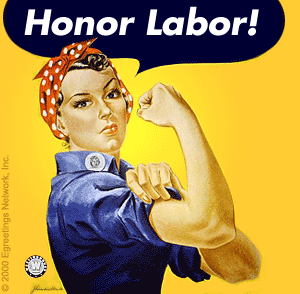
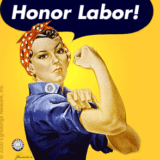
When I started Unionosity, my goal was to provoke discussion about important workplace and economic issues. Work is such a significant part of our lives – many of us spend the majority of our waking hours at it. Yet we don’t talk enough about what it means and how we can do it better — specifically, what can be accomplished if we work together.
Unfortunately, the “working together” part can sometimes go awry before it has the chance to begin. I’ve learned to be mindful of some of the predicaments that the working poor have long lived with. One of these I learned the hard way during an affordable housing campaign I took part in nearly 20 years ago in South Central Los Angeles. The program we were organizing around — ironically, a Jack Kemp HUD program — would transfer ownership of publicly subsidized housing to tenant groups made up of Section 8 voucher recipients,


I recently came across a men’s clothing store in Brentwood, a tony neighborhood of Los Angeles, with the provocative name Unionmade. I walked in and meandered around the shop, looking at the pricy shirts, pants, sweaters, jackets, shoes, and other articles of clothing. After examining the apparel, I couldn’t find any items with a union label. What gives?
I called Todd Barket, the store’s founder, to find out.
The 40-year old Barket told me that he’s spent his entire career in the men’s clothing business. After dropping out of Cal Arts, he went to work for Banana Republic, followed by 12 years at The Gap in merchandising, styling, advertising, and marketing, and then two years as Old Navy’s creative director for marketing and advertising. After he was laid off in June 2009, Barket began making plans to open his own retail clothing store, and by that December he’d realized his dream.


In a week dominated by the Republican National Convention, most silly quotes were related to the presidential campaign. Indeed, this entire page could have consisted of Clint Eastwood’s bizarre one-man sketch at the convention. (Best headline belonged to Wonkette: Fox News Suddenly Loves Hollywood Elitists After Clint Eastwood Yelled at a Chair.) Still, there was a bit of silliness for everyone.
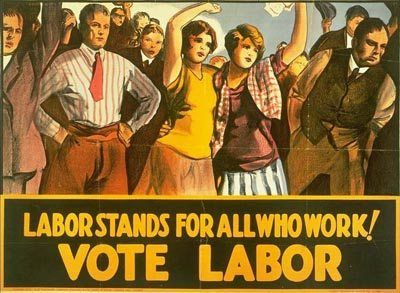
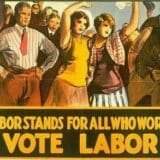
Like any holiday, Labor Day comes with some inevitable scenarios. Number One is that most Americans will take a well-deserved day off, courtesy of the efforts of the labor movement. Next, many of us will barbecue on grills that were paid for by middle class jobs that only exist because of the success of that movement.
But this holiday comes with another inevitability: The Sunday morning newspaper or Web stories proclaiming that people don’t want to join unions anymore. However, despite what the editorial writers and columnists say, the real reason people don’t join unions is that U.S. labor laws are so weak that they are nearly worthless – and the right to join a union is a joke.
When I went to work for my first employer after high school I was part of an organizing drive and a strong majority of the workers – 43 out of 62 – signed cards asking for a union to represent us.


Whether it was a newscaster scratching his head over yet another alleged Marilyn Monroe porn film or a conservative pundit worried about Congressman Todd Akin’s hurt feelings, people had silly things to say this past week. Here is a modest sampling.


Ohio banjo god Rick Good has been getting some YouTube mileage out of “This House Is Not for Sale,” a protest folk song in the tradition of “I Don’t Want Your Millions Mister.” Its roots may also include Woody Guthrie’s “Do-Re-Mi” and the hobo anthem “Big Rock Candy Mountain.”
The biggest inspiration behind Good’s populist lyrics, though, are plainly an election year in which America’s One Percent have been spending money like drunken sailors — make that drunken admirals — with the White House heading their shopping list. Sample lyrics:
You can buy a congressman. You can buy a judge.
You can back a super-pac and give your lies a nudge.
But we the people know the truth and we still have the right
To take a stand and build a land where money is not might.
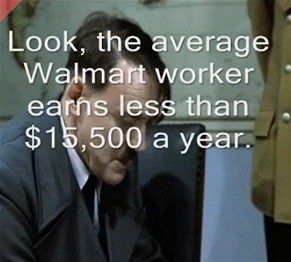
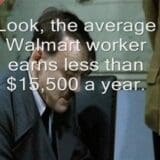
Last week we posted a video here on Frying Pan News, and apparently there’s some outrage. It seems some of our friends at Walmart felt we were comparing them to Hitler, and saw that as horribly unfair.
We got comments from Nikki Ung (ED of the Chinese Chamber of Commerce, which supports Walmart), Bill Imada (lobbyist for Walmart), Dennis Huang (ED of the Asian Business Association, which also supports Walmart) and Greg Jenkins (who may or may not be a Walmart store manager).
We can understand why they are a bit behind the times on this one. After all, the Hitler parody meme has only been around for five or six years, and written about in The New York Times as far back as 2008.
For their reference, however, we suggest they check out a few other videos.
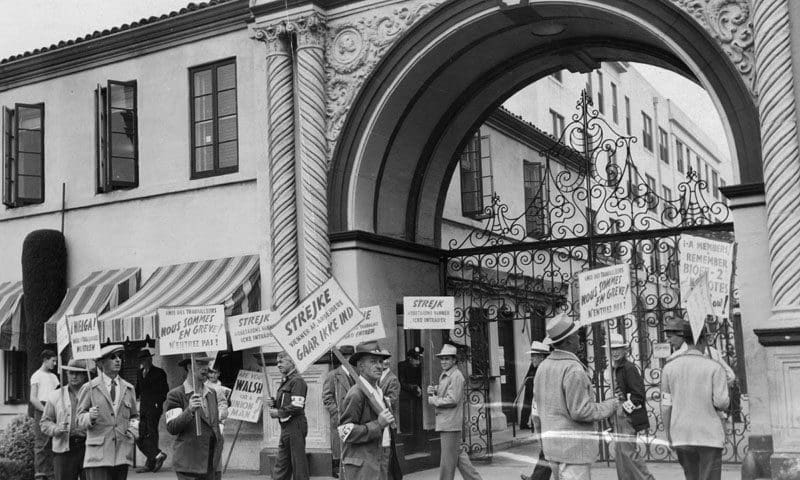
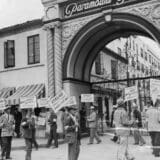
With large-scale domestic manufacturing off-shored and de-unionized, Hollywood film and television production may now be the most heavily unionized private-sector industry in the American economy. I had no idea when I started in the labor movement in the 1980s that I would get my foot in the (back) door of “the business” by working with some of the entertainment industry unions and guilds. Today’s “above the line” unions include the Directors Guild, the Writers Guild and the newly-merged SAG-AFTRA (Screen Actors Guild and American Federation of Television and Radio Artists); “below the line” unions encompass the IATSE (International Alliance of Theatrical Stage Employees – also called the “IA”), the Teamsters and others.
Though I barely knew which end of the camera to look through, I was first hired-on for some interesting projects by IA Local 600 – the Cinematographers Guild. When three regional camera locals were consolidated in the mid-1990s, I wrote and edited mail-outs to members about the merger and,
» Read more about: The Big Picture: Hollywood Unions Fight On »


Watch the latest video at video.foxnews.comLast week, much to my surprise, Bill O’Reilly invited me on his Fox News show, The O’Reilly Factor.
He was upset that I called him a “right wing buffoon” in my Huffington Post article, “Pete Seeger – In His Own Words – Graces the Colbert Report.” The article was actually about Pete Seeger’s appearance on Stephen Colbert’s show on Monday night.
In truth, the reference to O’Reilly in my Huffington Post piece was an after-thought. I was praising Stephen Colbert for inviting Seeger on his show and I suggested that Colbert lead a campaign to get Pete nominated for the Nobel Peace Prize. I wrote that: “Colbert’s show — including his faux campaign for president, his Super PAC, and his nightly send-up of Bill O’Reilly’s right-wing buffoonery — brilliantly satirizes the absurdities of America’s corporate-dominated political culture.
» Read more about: Peter Dreier's Five-Minute Debate With Bill O'Reilly »


I have been wading through the three volumes of Taylor Branch’s history, America in the King Years, and reliving the dozen years between Montgomery and Memphis. The Montgomery bus boycott catapulted Martin Luther King, Jr., into the national headlines; Memphis was where he was assassinated. Throughout that tumultuous time, the Reverend James Lawson stood just offstage, a key partner in the nonviolent campaign for full citizenship for African Americans.
While King spearheaded the campaign to desegregate the buses in Montgomery, Lawson trained students in Nashville in the ways of nonviolence. He led small workshops tucked away in church basements. He taught his students not to react to taunts and threats. He gave them tools to remain calm and centered while undergoing arrest or physical attacks. Lawson believed that only by enduring the blows of hatred could haters see their own humanity. He brought Gandhi’s understanding of nonviolence to this country and he trained thousands of civil rights workers during those years.

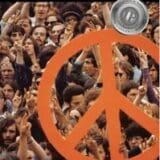
There are epic chapters in American history that inspire a seemingly endless flow of fiction, historical analysis and first-person reflection. Not least among these chapters is the 1960s, and the dramatic social movements that helped define that decade.
One of the newest entrees in the ’60s canon is Gates of Eden, a novel by longtime theater artist and political activist Charles Degelman. The anti-war movement is the canvas against which Degelman sets his story, and while the book is not autobiographical, the author knows his subject well. After graduating from Harvard in 1967, Degelman left Cambridge for San Francisco and joined the San Francisco Mime Troupe, the radical theater company grounded in the work of Bertolt Brecht. The troupe performed its anti-war repertoire across the country, partnering with Students for a Democratic Society (SDS), one of the leading activist groups of the era.
Degelman,
» Read more about: Author Charles Degelman on the Legacy of the 1960s »


When we think about professional performers, we generally assume they’re living the glamorous life, all day, every day. But that’s not always the case.
Indeed, the life of an actor, broadcaster or recording artist can be glamorous. But it can also be incredibly difficult for working performers when it comes to the everyday things, like purchasing health care insurance, or taking a rest break during a 20-hour shoot… even something as basic as removing the elaborate body paint we see so often in music videos these days can be a serious challenge.
That’s why, for decades, performers have been coming together in unions to bargain for fair protections and decent working conditions. And this year, actors and performers took their collective voice to the next level by voting overwhelmingly to merge the two biggest entertainment and media industry unions – Screen Actors Guild (SAG) and the American Federation of Television and Radio Artists (AFTRA) —
» Read more about: Interview With SAG-AFTRA's Gabrielle Carteris »
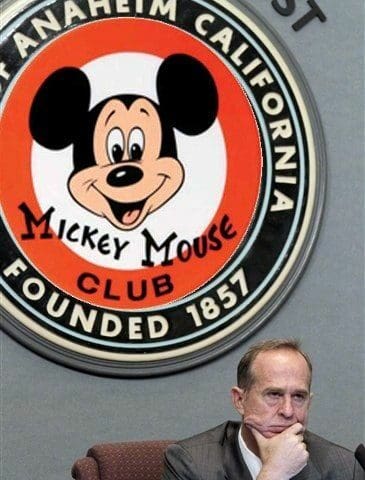
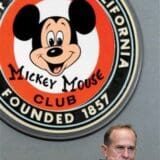
New headlines have emerged almost daily in the explosive weeks following the death of Manuel Diaz, who was unarmed when Anaheim police shot him on July 21st.The night after Diaz’s death, police shot and killed Joel Acevedo — the fifth fatal officer-involved shooting in Anaheim this year. A city council meeting set for Wednesday afternoon (August 8th) at Anaheim High School’s 1,300 seat auditorium is expected to be overflowing. The mayor, the police chief, angry residents—all make the news reports.
But Anaheim’s most high-profile denizen has stayed out of the spot light. “The Mouse”– Disneyland and Disney Corporation – has wisely avoided taking a high-profile stand that would mix the Disney brand with news of conflict and racial strife in Anaheim, where tourism is king.
While Disney doesn’t govern police policy (although some residents argue to the contrary, citing Disney’s influence in the city), The Mouse does unquestionably wield major influence in shaping Anaheim’s economic development gestalt,


There’s a scene in Lauren Greenfield’s likable documentary, The Queen of Versailles, in which the titular monarch, the wife of time-share mogul David Siegel, announces she is shoveling $2,000 worth of caviar into her mouth. “Somebody’s gonna get fired,” grumbles her husband, a former billionaire who is now desperately pinching pennies as his creditors tighten a noose around his troubled empire.
The film is full of such jarring moments, making it partly an American economic fable, partly a reality TV show. Like many such train wrecks, the story takes place in Florida and, like many a tale of real estate rise-and-ruin, it begins on the eve of the recent recession. That’s when Greenfield set out to capture the Siegels’ construction of the largest house in America – a 90,000-square-foot monstrosity inspired by both Louis XIV’s court at Versailles and the Paris Las Vegas hotel and casino. Among other things, its floor plans called for 23 bathrooms,


Richard Kirsch has dedicated his life to fighting for universal affordable healthcare. A senior fellow at the Roosevelt Institute and author of numerous studies on healthcare reform, Kirsch wrote New York’s Managed Care Consumer Bill of Rights. Perhaps most notable, however, is the role he played in transforming the recent political discourse with his revolutionary proposal: the public option.
In his new book, Fighting for Our Health: The Epic Battle to Make Health Care a Right in the United States, Kirsch describes the uphill struggle to bring health care to everyone. The book doubles as a memoir and ode to the power of progressive grassroots organizations. He chronicles the history of health care reform as well as his own experience designing and pushing forward the public option — a middle road between private insurance and single-payer coverage.
At a book party and fundraiser at the California Endowment,
» Read more about: The Man Behind America’s Health Care Reform »
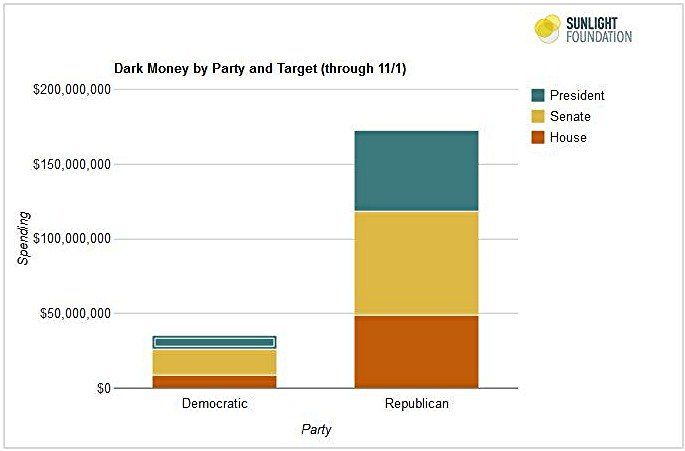
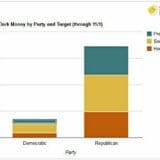
My wife and I saw the new Batman film this weekend. We’re not blockbuster fans but occasionally enjoy a bit of escapism. An escape from reality, of course, is what the moviegoers in Aurora, Colorado were looking forward to last Friday midnight before a gunman suddenly began firing into the audience. The reported initial reaction of some of the filmgoers was chillingly revealing – they thought the shots were part of the show. That hope immediately vanished, but it served as a mad metaphor for a society that increasingly has trouble distinguishing where fantasy ends and real life begins. For people in Aurora last week, escapism meant fleeing a movie, not attending one.
America, shocked as it was by the carnage, didn’t seem particularly enthusiastic to search for causes or lessons, let alone metaphors. So the ensuing discussions, in the mainstream media, at least, were mild compared to those that followed disasters from Hurricane Katrina onward.
» Read more about: The Aurora Shooting: Life Imitates Death »
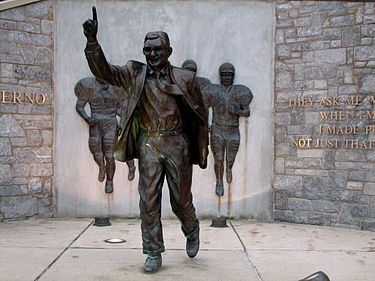
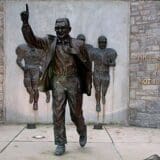
Last week Penn State University released a report by former FBI Director Louis Freeh about the Jerry Sandusky scandal. It confirms what most of us already believed—that the leadership at Penn State had reason to believe Sandusky was molesting children but failed to do anything.
Sandusky’s been convicted, and several key officials—Penn’s president Graham Spanier, athletic director Tim Curley and football coach Joe Paterno —have been fired or have been convicted in the press and will likely soon be convicted in a court. (Paterno died last January.)
Now the debate is turning to the responsibility of the National Collegiate Athletic Association (NCAA), the idea being that the NCAA should impose sanctions on Penn State.
The main idea of this debate is that Penn State’s cover-up says something about the influence of football on a college campus, and on our culture at large. It doesn’t. This isn’t to say the Paterno legend is irrelevant,
» Read more about: The Penn State Scandal: It’s Not About Football »
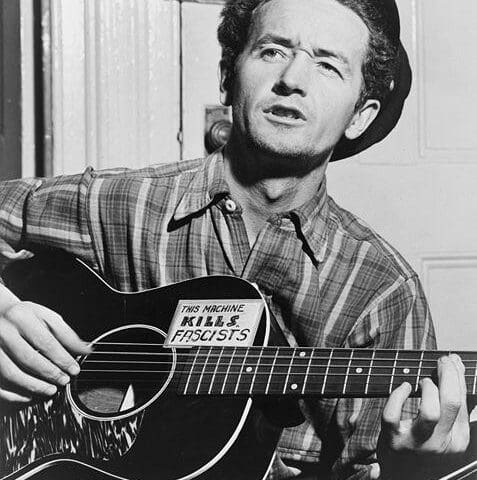

The words of some songs seem to ring true forever. Especially Woody Guthrie’s “Do-Re-Mi,” with its scathing appreciation of life in the Golden State:
California is a garden of Eden, a paradise to live in or see;
But believe it or not, you won’t find it so hot
If you ain’t got the do-re-mi.
This Saturday, July 14 (Bastille Day!), A Better World’s A-Coming honors the Dust Bowl Bard’s 100th birthday with “An Echo Park Tribute to Woody Guthrie”  – what its organizers, the Trailer Trash Project (TTP), are calling “a free backyard picnic celebrating the life and music of Echo Park resident Woody Guthrie.” But wait, there’s more! “Enjoy an afternoon concert of hip-hop, blues, jazz, psychedelic and bluegrass by Woody-inspired musicians. Art activities [including children’s music and storytelling] will take place throughout the day.
– what its organizers, the Trailer Trash Project (TTP), are calling “a free backyard picnic celebrating the life and music of Echo Park resident Woody Guthrie.” But wait, there’s more! “Enjoy an afternoon concert of hip-hop, blues, jazz, psychedelic and bluegrass by Woody-inspired musicians. Art activities [including children’s music and storytelling] will take place throughout the day.
» Read more about: Woody Guthrie at 100: This Party Is Your Party »

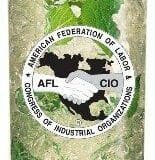
You don’t have to go to Havana to enjoy a good mojito (although such a visit would give you the chance to savor the old Bacardi headquarters, a jaw-dropping example of tropical art deco). Here’s a recipe from our friends at LA Labor 411, who keep you up to date on what goods and services bear the union label.
Looking to sip into something a little more comfortable? Why not try a union-made mojito. Here’s how to build the ideal cool cocktail for those hot August nights that are right around the corner. Make one for yourself and then raise a glass to all the union workers who did such an amazing job repairing the 405 Freeway.
Ingredients:
1.5 oz. of Bacardi Superior Rum
half cup club soda
12 mint leaves
half a lime
1 tbsp.
» Read more about: Brother, Can You Spare a Lime? (Union Mojitos!) »